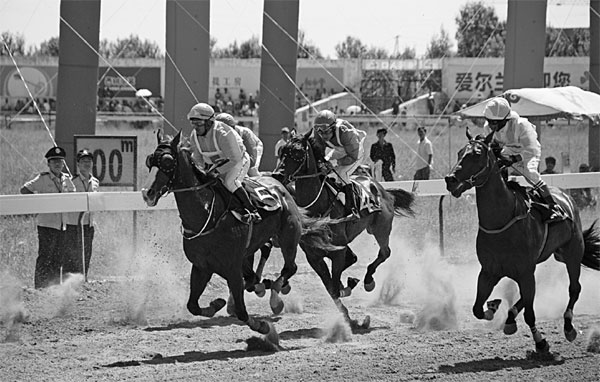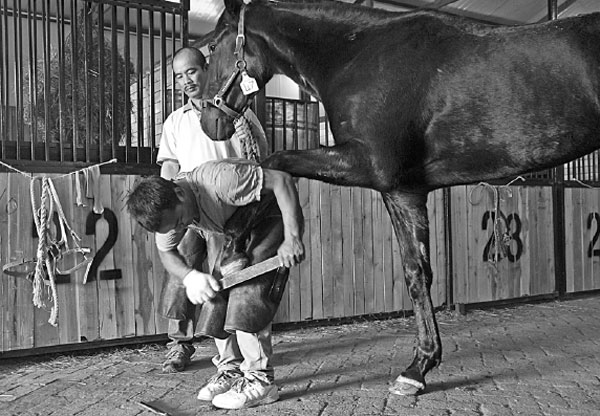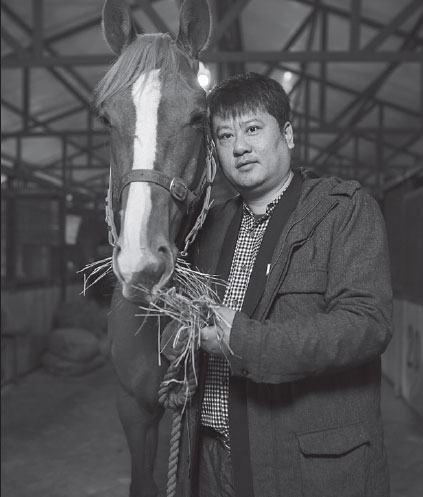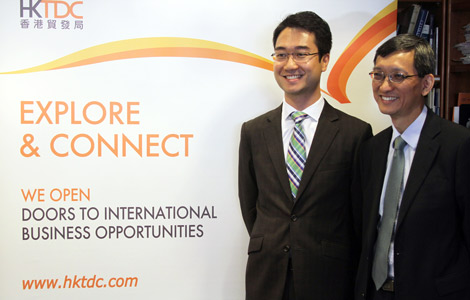Entrepreneur bets on horse success
Updated: 2014-10-01 08:00
By Lyu Chang in Tongliao, Inner Mongolia(China Daily USA)
|
||||||||
Equestrian owner counting on China's newly rich to take up riding, racing and purchasing of his pricely ponies.
The excitement of the crowd can be felt as well as heard around the equestrian field where horses gallop across the turf.
But instead of the manicured race course at Happy Valley in Hong Kong or the green pastures of the United Kingdom, this horse race in August took place in Tongliao, a city in Inner Mongolia that boasts China's best grassland and breeds world-famous Mongolian horses.
|
Horse-racing events are held regularly in Inner Mongolia, which boasts China's best grassland and breeds world-famous Mongolian horses. Racing rules are similar to those of Hong Kong. Jian Jun / For China Daily |
|
A farrier apprentice shoes horses under the supervision of an experienced farrier, who has been working in Macao for decades, and earns approximately 300,000 yuan a year. Provided to China Daily |
|
Lang Lin checks on his horses every day. He owns more than 800 of them. Provided to China Daily |
Although no betting is allowed during the Jirem Horse Racing Festival, there are prizes available, including one totaling more than 200,000 yuan ($32,573) that went to Lang Lin and his riders after their horses won seven gold medals of the total nine races, including the running of the 2,000- and 5,000-meter races.
Lang, owner of Inner Mongolian Rider Horse Co Ltd, which he started in 2006, is a horse-racing fanatic who appears regularly at racetracks at home and abroad to watch over his vast stable of thoroughbreds, imported from New Zealand, and to see the horses compete.
"Polo and equestrian events are becoming a new way for the Chinese nouveau riche to relax and show their social status," said Lang, who now owns more than 800 horses, including thoroughbreds, Mongolians and halfbloods.
"In China, riding and watching polo is just starting to become a trend, and many will also buy horses, just as they have dogs, cats and other pets at home," he said.
As more wealthy Chinese are choosing equestrian sports as a marker for wealth and status, the number of polo clubs in China has risen from fewer than 100 in 2007 to more than 1,200 in 2013, and it is still growing, with an average increase of 30 percent per year, according to data released by the China Horse Industry Association.
But not many polo clubs are actually gaining profits, Lang said.
"It is still in its infancy, because only a few Chinese can ride and play," he said.
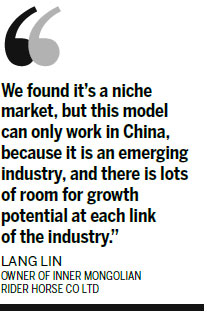
Polo clubs account for just a small part of his horse-related businesses, which range across the entire industrial chain, from the upstream - horse breeding - and the mid-stream - horse feeding - to the downstream: feedstock trading, polo clubs and clinics.
Lang said his is the first and only China-based horse business to receive private equity from venture capital companies.
Eyeing the huge market potential, three venture capital companies have injected a total of 170 million yuan into his company, which he has used to build stud farms, a racetrack, a members-only hotel, polo clubs, a feedstock trading center and a quarantine center, where imported thoroughbreds can undergo a month of isolation before mixing with local horses.
"We found it's a niche market, but this model can only work in China, because it is an emerging industry, and there is lots of room for growth potential at each link of the industry," he said while greeting the company's jockeys as they arrived.
But like many equestrian clubs, the company is also looking for members and patrons who can afford to buy horses and board them at the company's stables. On average, the club horses, purchased mainly from breeders in New Zealand, cost around $20,000 each, with monthly boarding expenses coming in at about 3,000 yuan.
Polo players at Rider Horse insist that this is not the new arrival of polo in China but a kind of renascence, as the link to horse riding goes back to the Tang Dynasty, 1,000 years ago.
There's a saying among the Mongols that "the nomad is born in the saddle," and many do seem to be born riders in Inner Mongolia, home to the best Mongolian horses in China. It is also one of the reasons that Lang located his company on the Khorchin prairie.
"The game will come back in fashion again, alongside golf and wine, since we had such a good culture in China," Lang said.
The horse industry has generated revenue of $39 billion annually in the US, and it has a $102 billion impact on the US economy when the multiplier effect of spending by industry suppliers and employees is taken into account, according to the United States Equestrian Federation.
Compared with the US, China's horse industry accounts for but a fraction of the nation's total economic volume. But Lang said it is only a matter of time before China catches up with the traditional horse-riding markets, especially if China lifts its ban on wagering on horses in the future.
But Pan Bingyou, a former executive at the Hong Kong Jockey Club, said that although many horse companies are running test races, he expects there to be no betting on horses in the foreseeable future.
"Football lotteries are allowed now in China, so I see no reason why a horse-betting event can't happen in China," Pan added. "If approved, an estimated 3 million jobs could be created."
Annual lottery sales could reach 100 billion yuan, with 40 billion yuan in tax revenue annually, according to Qin Zunwen of the Hubei Provincial Academy of Social Sciences.
But he said that as the horse industry expands, the demand for professional horse trainers, riders, farriers and horse veterinarians will rise accordingly, which will likely become a bottleneck for the industry.
In Lang's club, an experienced farrier who has been shoeing horses in Macao for decades earns approximately 300,000 yuan a year, nearly five times higher than the average income in big cities like Beijing.
Li Jiafei, a club equestrian from Hunan province, said it takes a lot of time and effort to be a rider, not to mention the hardship he endures such as hunger and injuries during training.
Li, who is 167 centimeters in height, said he is always on a diet to keep his weight under 50 kilograms so his horse can run fast with a lighter load. But he doesn't regret becoming to be a rider and said he enjoys every minute he spends with the horses.
In 2013, Rider Horse raked in 50 million yuan in revenue with a net profit of 20 million yuan, with most of the yield coming from the breeding and trading sectors. It is still growing, and Lang predicts that sales revenue will triple this year.
In addition, the company is preparing for an initial public offering in Shenzhen's Growth Enterprise Market, known as ChiNext, to have access for further capital for growth.
Among its ambitious plans: to build China's largest horse-breeding center to develop the best domestic thoroughbred, halfblood, warmblood and Mongolian horses to serve the growing needs of China's horse lovers and equestrian clubs.
"If we succeed, we will become the first listed company in the horse industry," Lang said.
lvchang@chinadaily.com.cn
(China Daily USA10/01/2014 page9)

 Chinese show love for country ahead of National Day
Chinese show love for country ahead of National Day
 Latest report on 100,000 Strong Initiative is discussed
Latest report on 100,000 Strong Initiative is discussed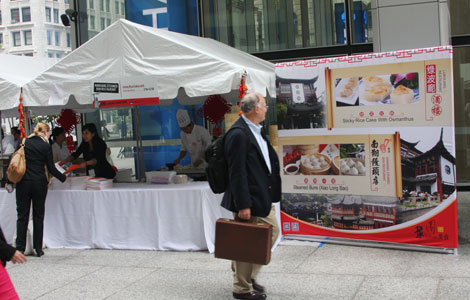
 Dine Around Downtown returns for 13th year
Dine Around Downtown returns for 13th year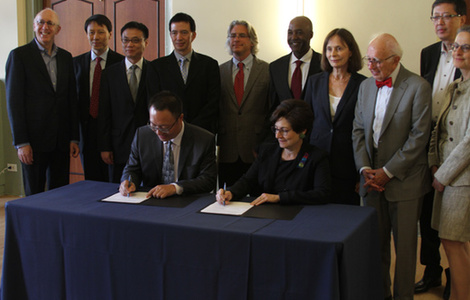
 Perfect World signs MoU with Columbia University
Perfect World signs MoU with Columbia University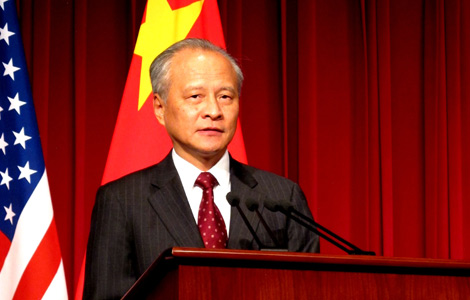
 China, US bid to work together
China, US bid to work together
 Xinjiang's first high-speed railway to start operation
Xinjiang's first high-speed railway to start operation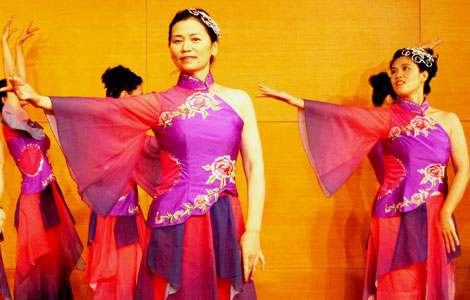
 Ambassador's National Day greetings
Ambassador's National Day greetings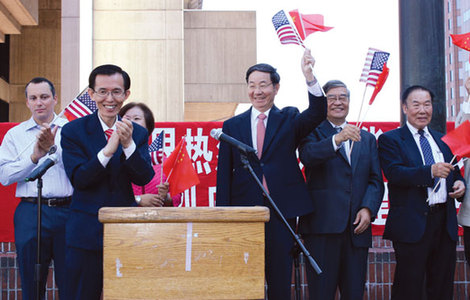
 It's time to celebrate
It's time to celebrate
Most Viewed
Editor's Picks
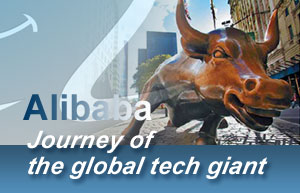
|

|

|

|

|

|
Today's Top News
First Ebola case reported in US: CDC
100 foreigners get Friendship Award
US firms remain optimistic about China
China marks first Martyrs' Day
Chinese, Indian troops withdraw from border standoff
China eases home purchase restriction
Protest continues in HK as bus service interrupted
Donation from Chinese group enables classes to keep going
US Weekly

|

|
